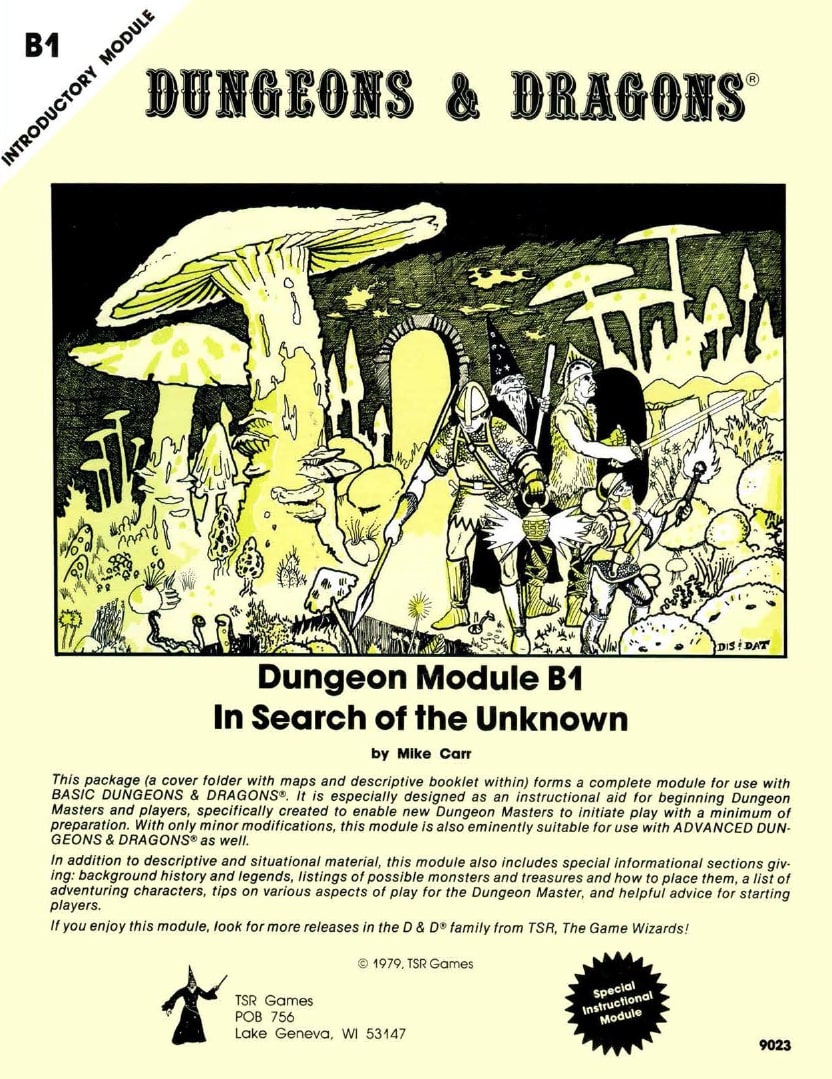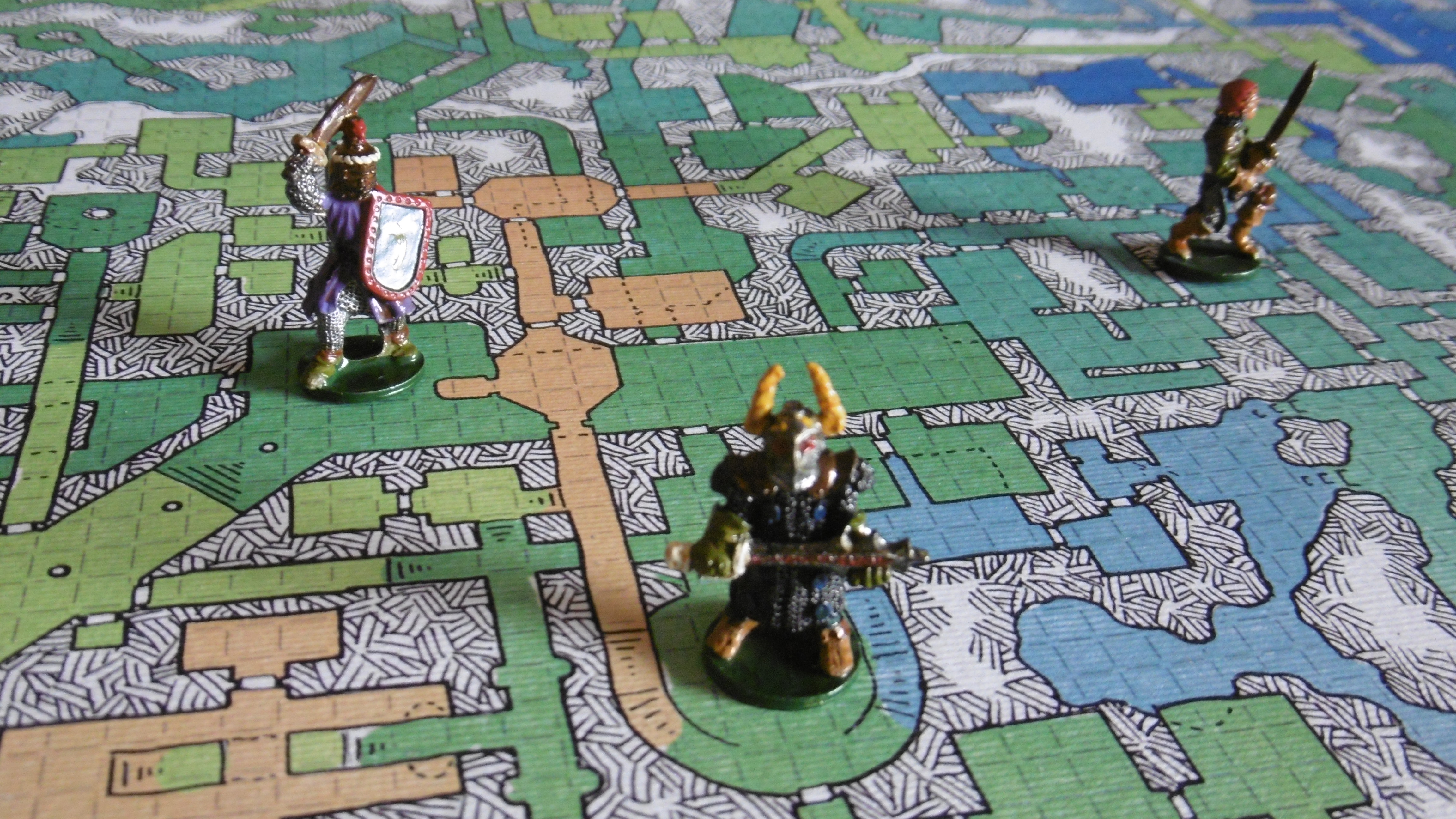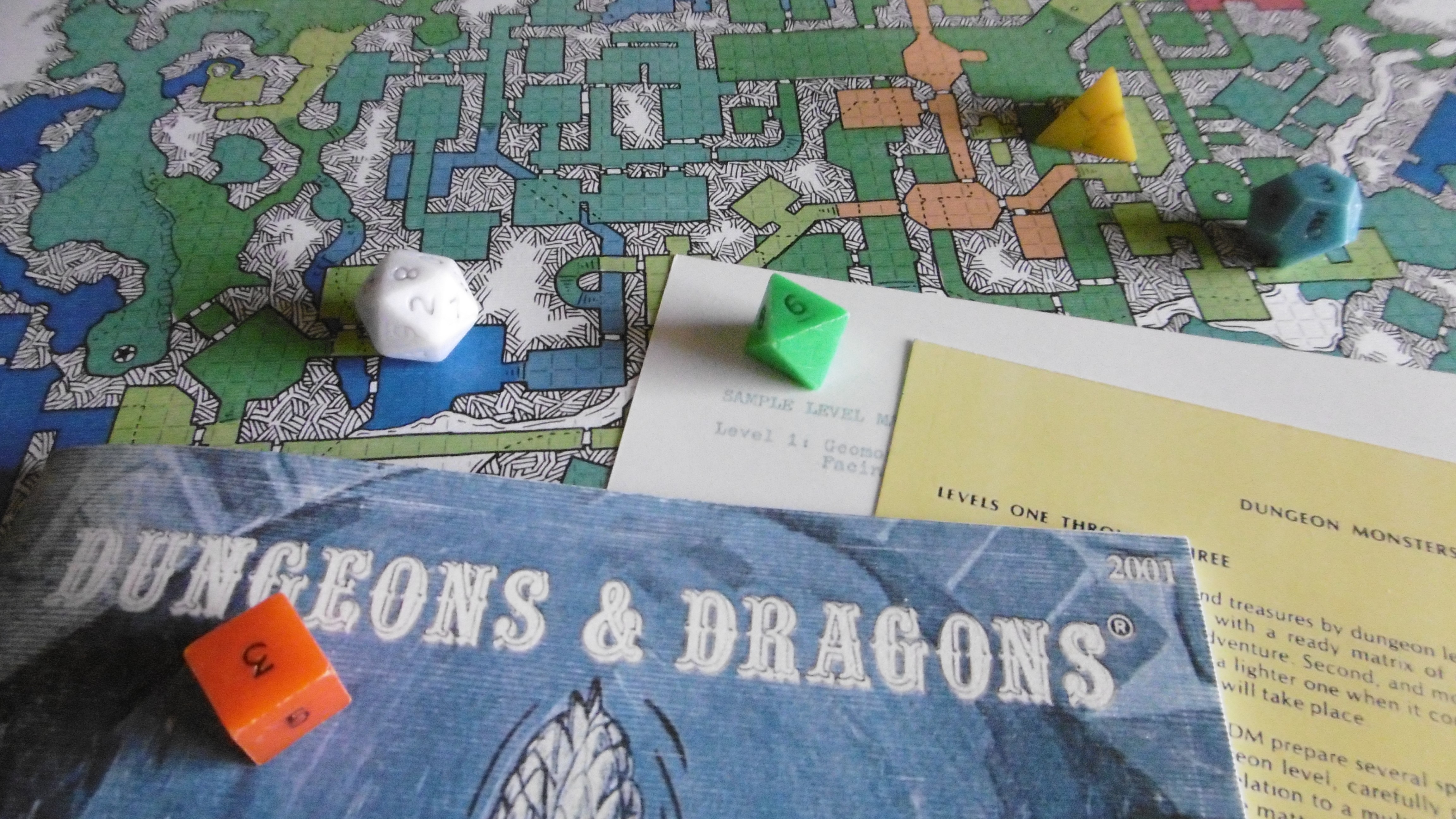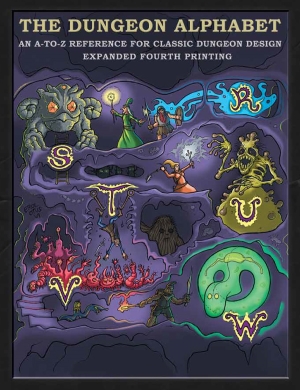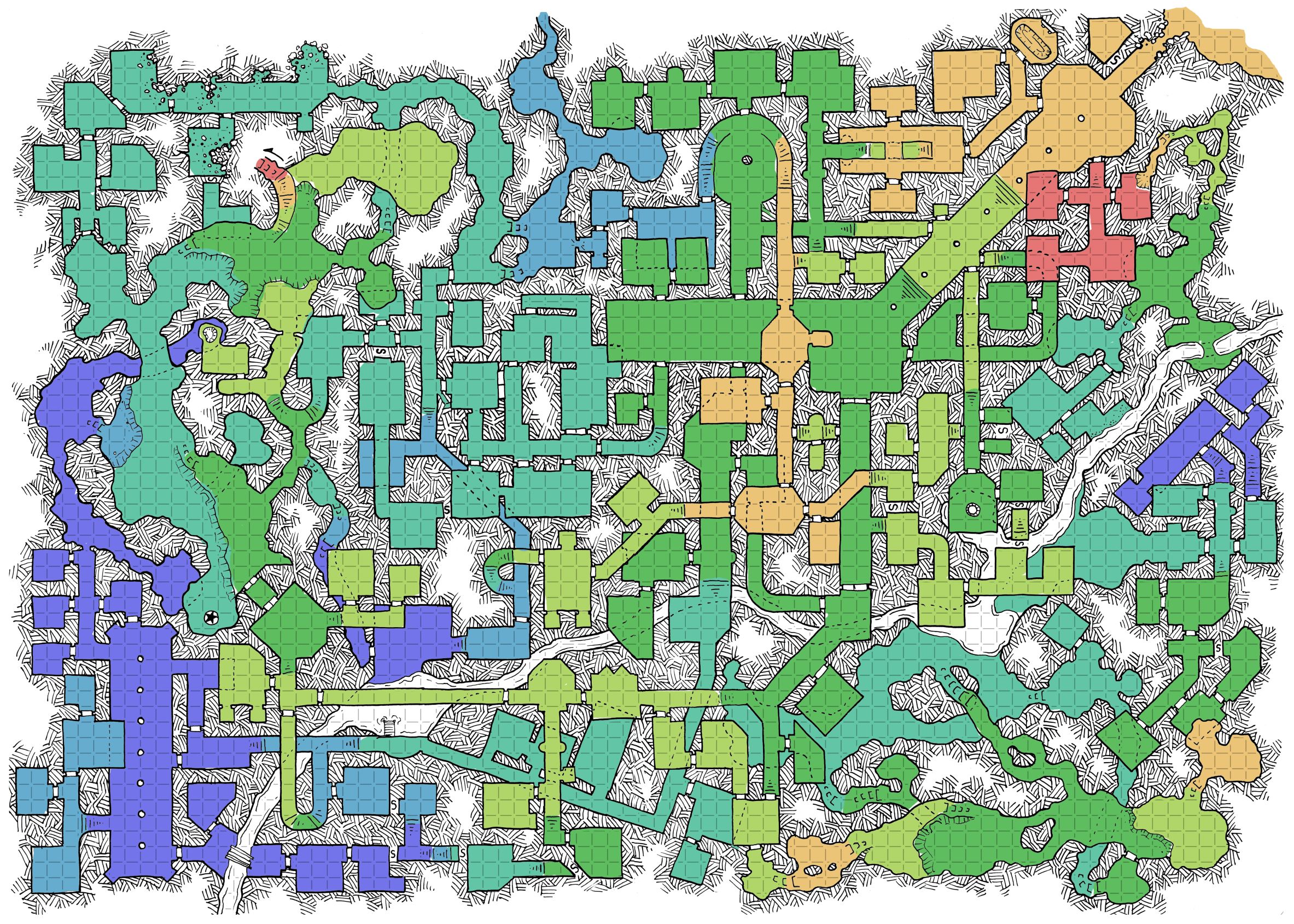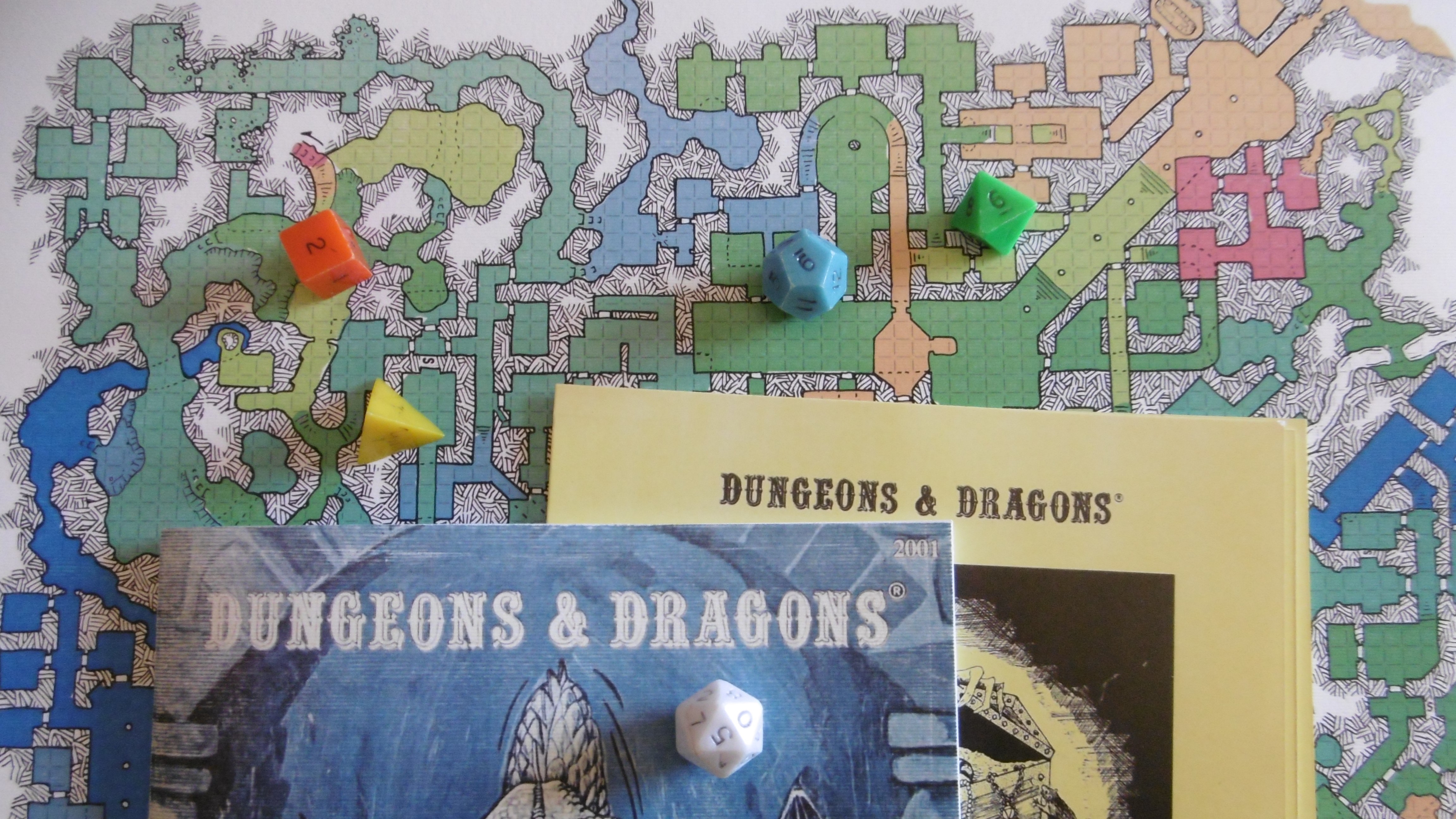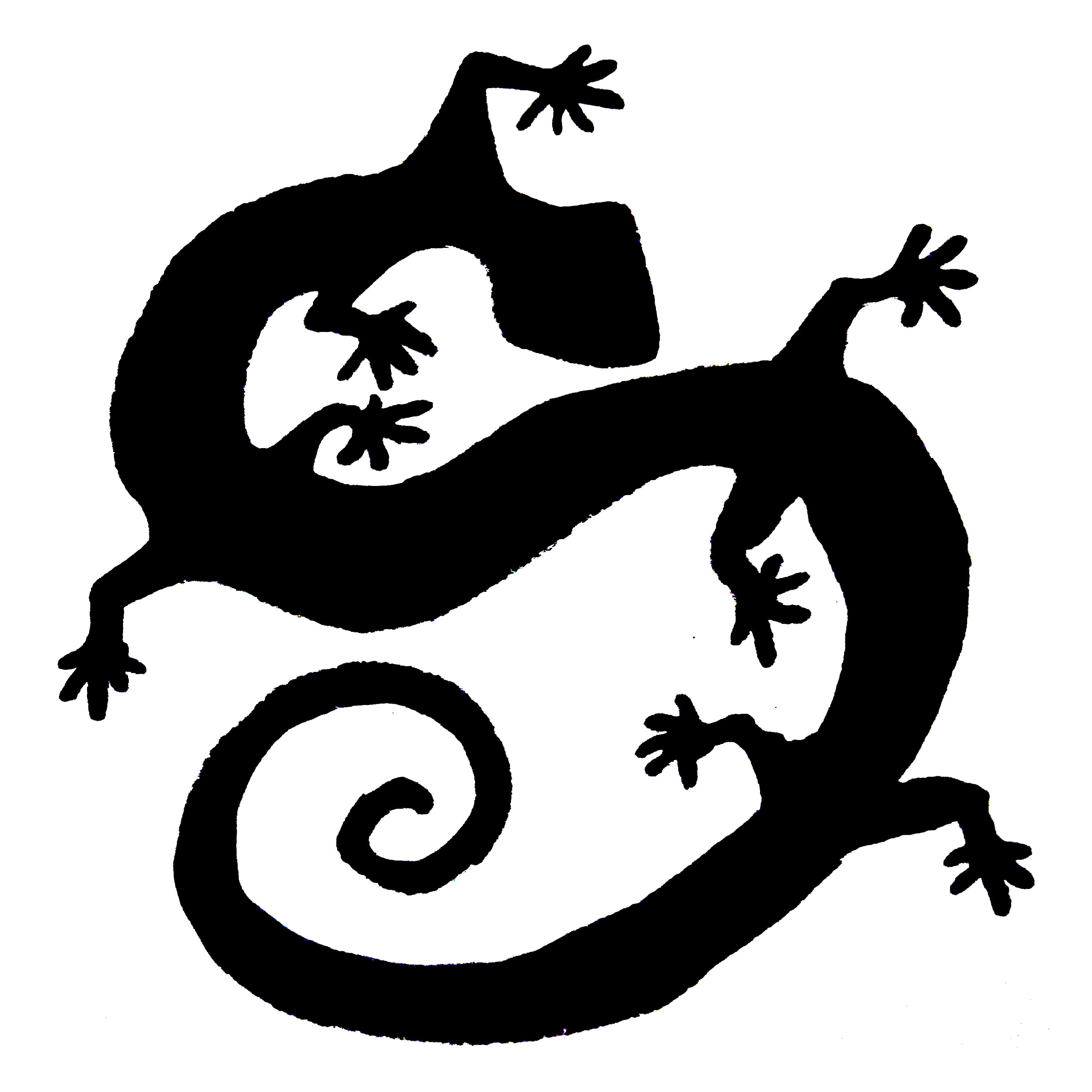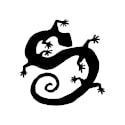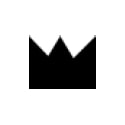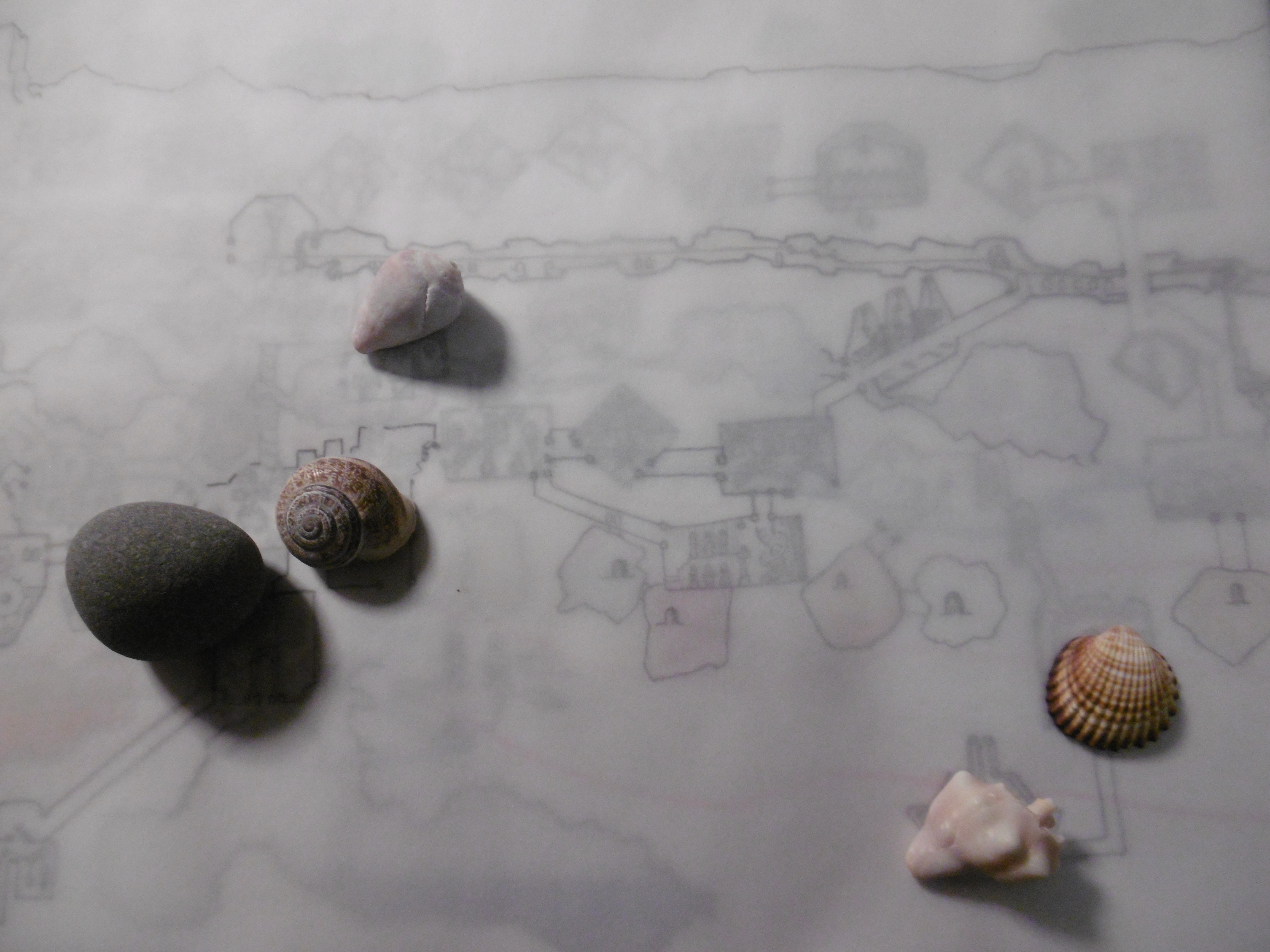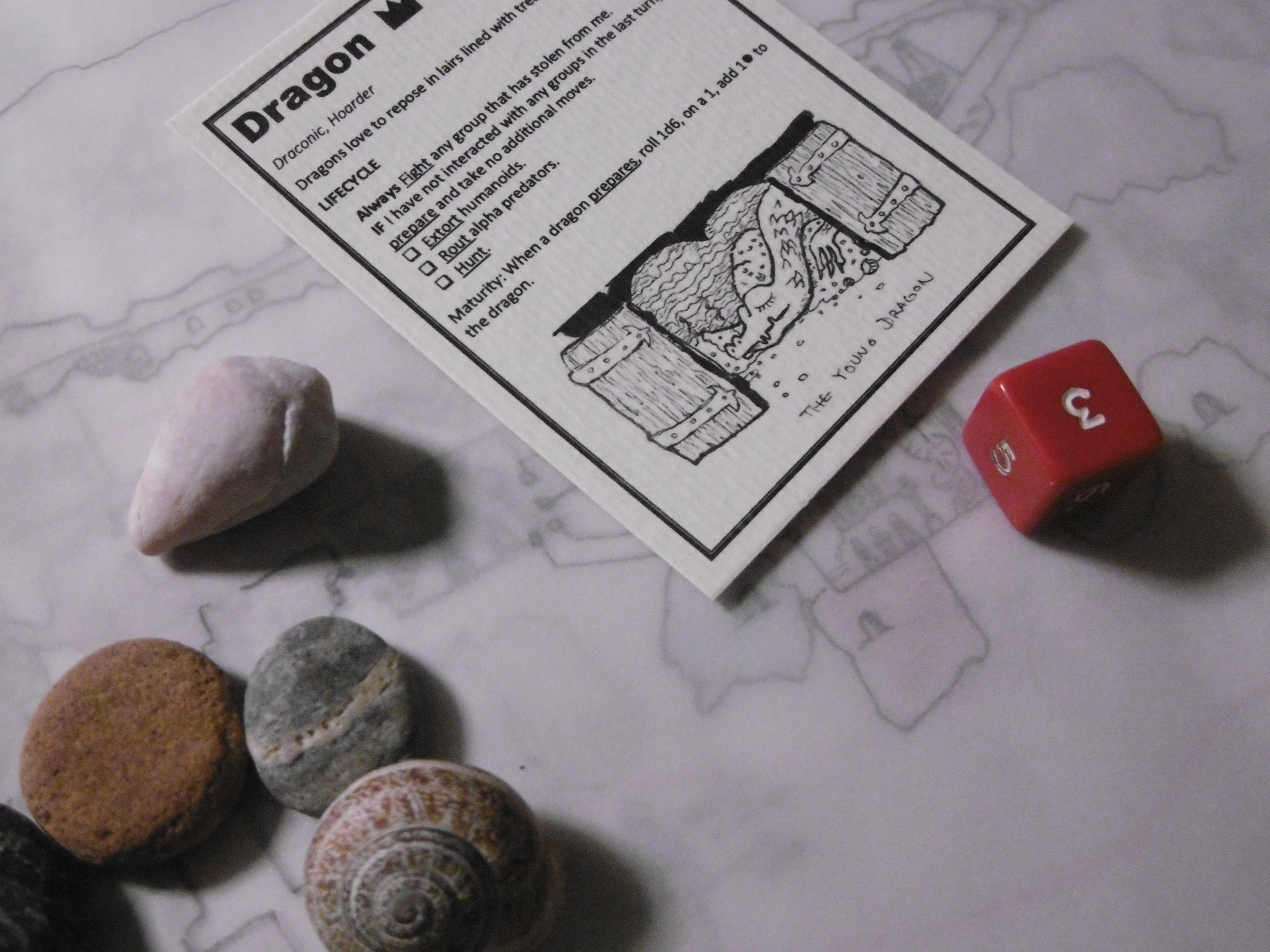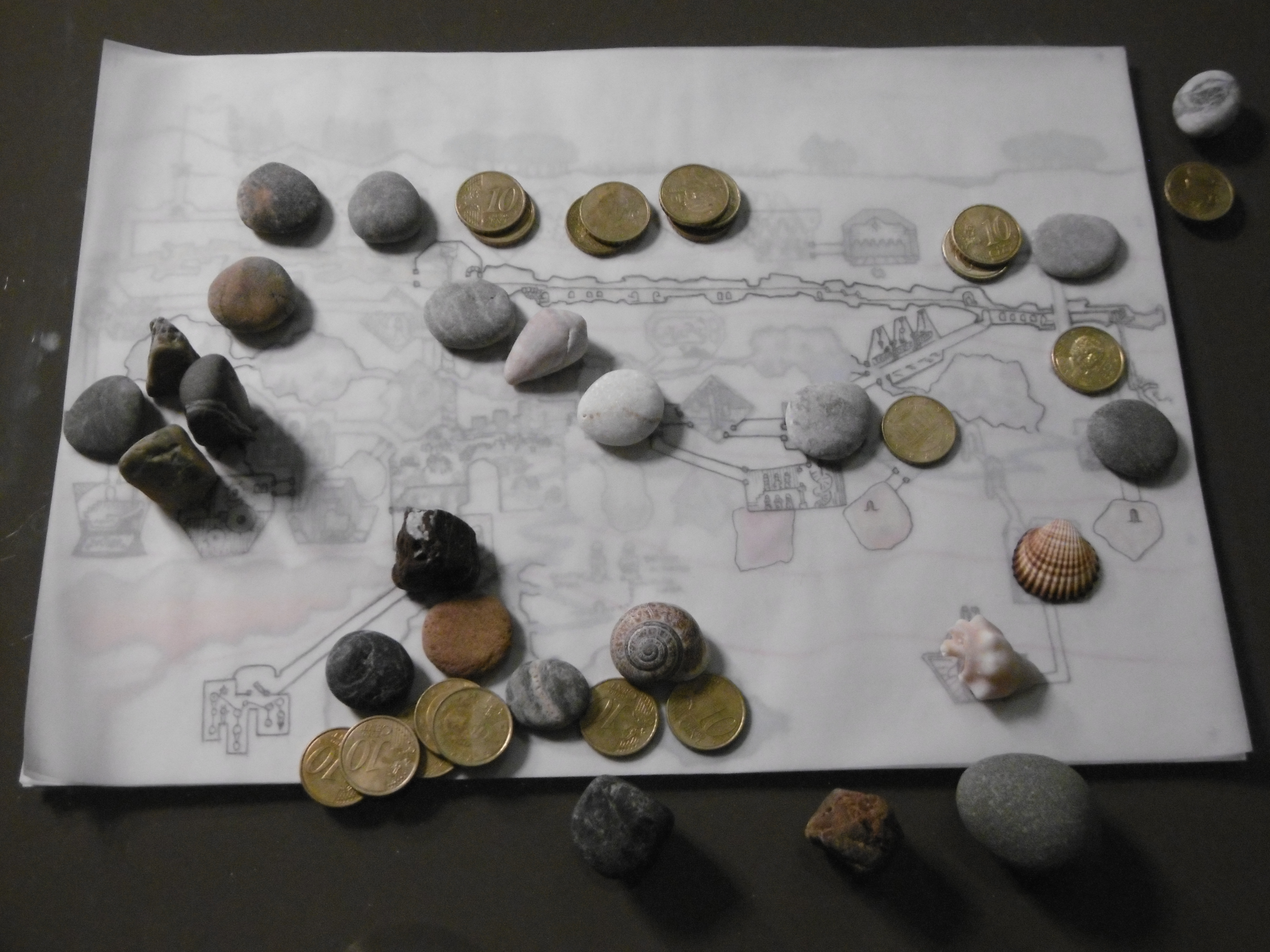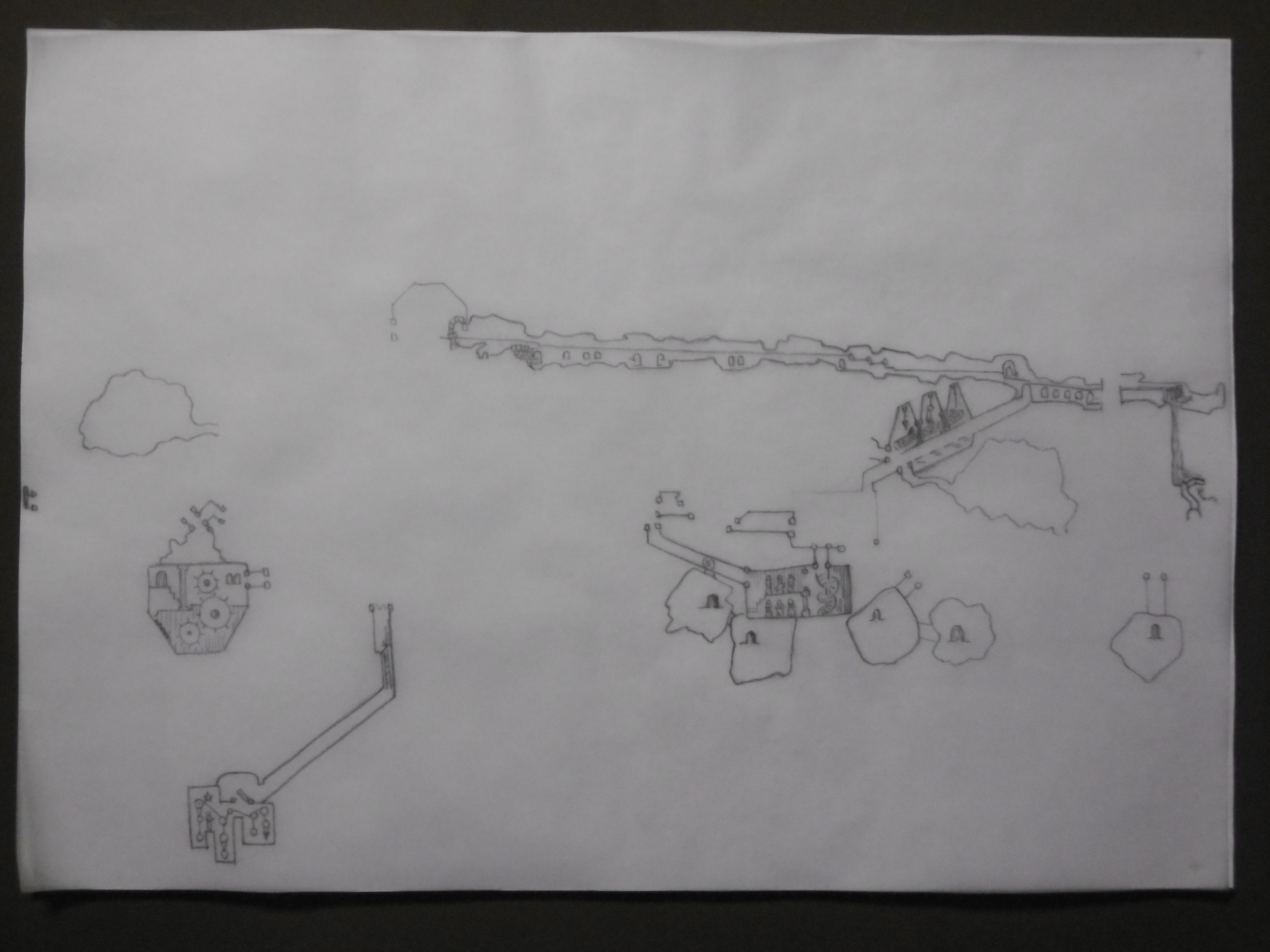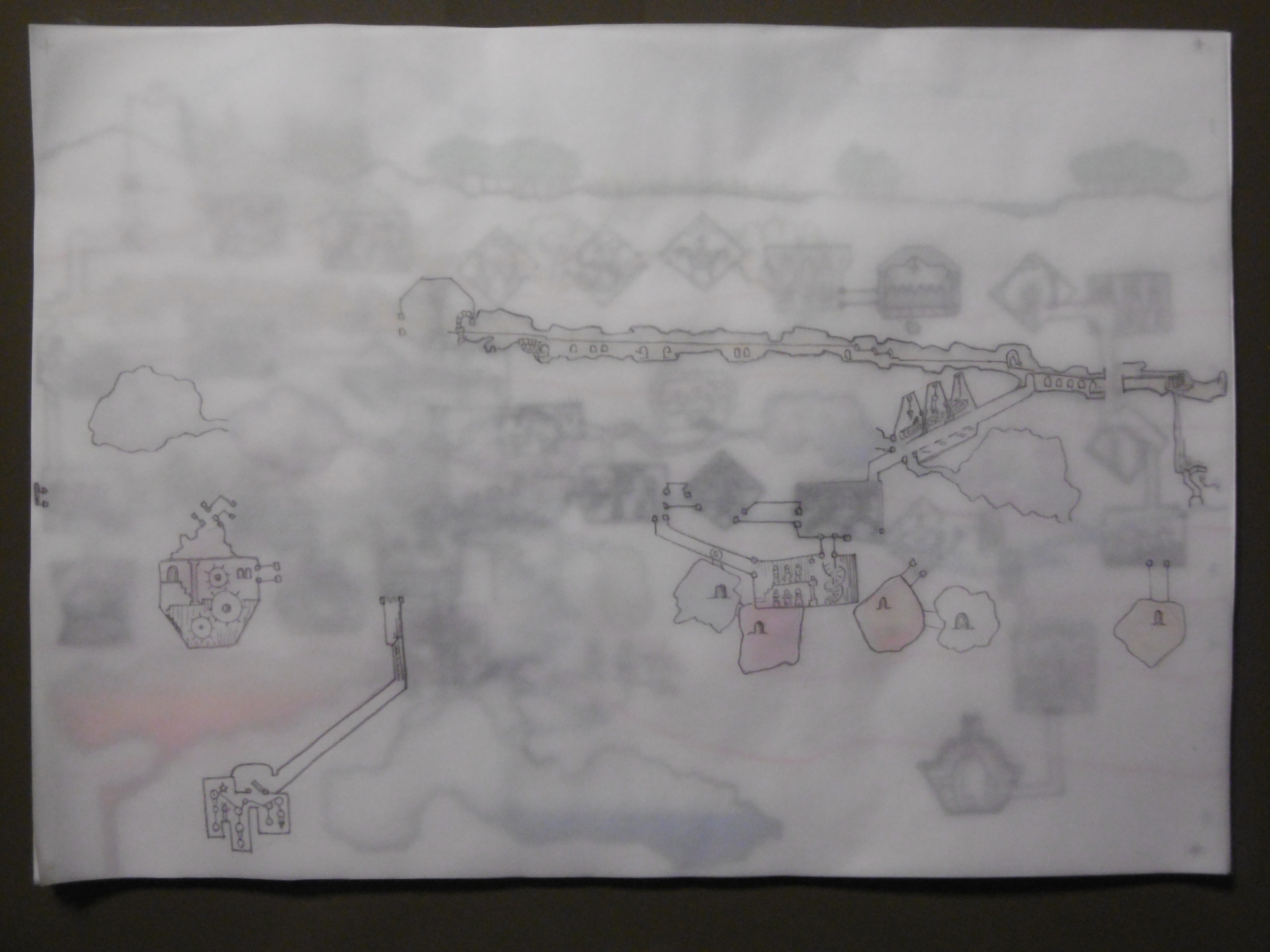A “Monty Haul” Dungeon
This is a continuation of a previous article: “One Deadly Dungeon.” It is the sixth in a series in preparation for a Holmes Basic D&D campaign Dreaming Amon-Gorloth.
Problem: Whereas, a party of three 1st-level adventurers needs 6,513 XP to advance a level, the maximum they might extract from The Deep Halls Level 1 is 4,277 XP.
Solution: Add more treasure.
Reading Map
While probing ahead with the ten-foot pole, do not be alarmed by any clinking noise.
How Much Gold
Exploring Level 1, our clever party of three should earn 6,513 XP. Of that, 1,525 come from monsters. The balance of the necessary XP must come from treasure.
6,513 − 1,525 = 4,988 XP from treasure
Previously, we found that the average value for a roll on the M&T Level One treasure table is 143 g.p. As a “single” treasure on the Flying Dungeon Stocking Table, one roll is not enough to achieve a 1:1 ratio, experience stocked to that necessary.
To find out how much treasure is needed per single treasure, we reverse the equation, substituting t′ for one roll on the treasure table. Again, I add parentheses around each treasure denomination, unnecessary in mathematical notation, for the sake of readability.
(5 areas × 2t′) + (8 areas × t′) + (2.5 areas × ½t′) = 4,988 g.p.
19.25t′ = 4,988 g.p.
t′ = 4,988 ÷ 19.25
t′ = 259 g.p. (dropping the less precious metals)
So, to get a single treasure worth 259 g.p., we need to roll 1.81 times on the treasure table.
259 g.p. ÷ 143 g.p. = 1.81 rolls
If we round up to two rolls on the table for a single treasure, we roll four times for a double, and only once for a half treasure.
Where t equals 143 g.p.,
(5 areas × 4t) + (8 areas × 2t) + (2.5 areas × t) = 38.5t
38.5t = 5,505 g.p.
Now our party of three earns a total of 7,030 XP or 2,343 each.
1,525 + 5,505 = 7,030 XP ÷ 3 characters = 2,343 XP per character
Everyone, save the magic-user and any elves, advance one experience level before proceeding downstairs with some confidence.
Adjustments
“We should consider that some monsters prove too tough and some treasures go undiscovered. Further, attrition extracts earned experience from the pool.”—from “One Deadly Dungeon”
We aren’t done yet. Remember the clever party. It is a clever party indeed which defeats all the monsters in the dungeon and finds all the treasures. Furthermore, if we stock only just enough experience, then the DM may be tempted to fudge combat rolls and to hint and cajole less clever players into searching where they would have gone on to the opposite door.
Instead of treasures, it’s the clues to the treasures, but it’s the same “give away show” the editor warned us about. Players learn to look for the DM’s cues and
“seldom become truly able, often losing interest in the game because there is no challenge, no thrill of ‘risking your life.’” (Holmes, 22)
Too-tough and Undiscovered
By how much should we pad the ratio to account for too-tough monsters and undiscovered treasure? I’ve no idea how to calculate it. But “a clever party” provides a different approach.
Using the rule of thirds, if “a clever party indeed” finds all the treasure, then “a clever party” finds two-thirds of it, while “a less clever party” finds only one-third.
In other words, where the clever party is successful, the less clever party fails, and the clever party indeed clears the dungeon and carries the dagger +1 hidden in the spider’s abdomen back to Portown.
So, by multiplying stocked XP by 1.5, we enable success for the clever party, while allowing room for the clever party indeed to be more successful. Needing two-thirds of stocked XP ensures the game doesn’t become the give away show.
Attrition
Another consideration, as important, is attrition. Slain player characters take earned experience with them beyond the veil. Again, the factors involved are beyond calculation. Let’s apply the rule of thirds one more time.
Twice The Rule of Thirds
On the rule’s first application, the clever party needed to find two-thirds of the treasure. A second application reduces that number by one-third again. Now the clever party needs 44% of stocked XP to advance a level.
2⁄3 × 2⁄3 = 4⁄9 or 44%
By the equation below, a clever party of three finds 44% of 14,803 XP, which is 6,513 or 2,171 XP each.
Where s is the number of stocked XP,
44% × s = 6,513 XP
44% 44%
s = 14,803 (rounded up)
Rolls per Treasure or Treasure Sequence
So, we have to recalculate the number of treasure rolls based on 14,803 as the target for stocked XP. We remove the XP from monsters, which doesn’t change,1 and recalculate t′.
14,803 − 1,525 = 13,278 XP needed from treasure
(5 areas × 2t′) + (8 areas × t′) + (2.5 areas × ½t′) = 13,278 g.p.
19.25t′ = 13,278 g.p.
t′ = 13,278 ÷ 19.25
t′ = 689 g.p.
To get 689 gold, we roll 4.81 times on the treasure table for a single treasure.
689 ÷ 143 = 4.81 rolls
Rounding up to five rolls for a single treasure, a half treasure would be 2.5 rolls. When we round 2.5 to three, a Fibonacci sequence appears ahead in the shadowy limit of the lantern’s glow. Let’s look at that in a moment.
Preliminary Sequence: 10-5-2
With a single treasure of five rolls, we have before us a double treasure worth ten rolls.2 If we round down half of five to two rolls for a half treasure, we have a treasure sequence3 of 10-5-2, which shoots 307 g.p. over the mark.
Where t equals 143 g.p.,
(5 × 10t) + (8 × 5t) + (2.5 × 2t) = 95t = 13,585 g.p.
13,585 − 13,278 = 307 g.p.
Base Sequence: 10-5-1
Since the party finds it in a room without a monster, I favor reducing a half treasure (though hidden and trapped) to a single roll.
Where t equals 143 g.p.,
(5 × 10t) + (8 × 5t) + (2.5 × t) = 92.5t = 13,227 g.p.
13,227 − 13,278 = -51 g.p.
It falls just short of the mark, but it puts the party within “a 10 foot circle of protection”—to use a Holmesism. Let’s call this our base sequence.
Fibonacci Sequence: 8-5-3
By adjusting the number of rolls for each of three magnitudes of treasure—double, single, half—many variations are possible. As an example, let’s have a closer look at the Fibonacci sequence.
Where t equals 143 g.p.,
(5 × 8t) + (8 × 5t) + (2.5 × 3t) = 87.5t = 12,512 g.p.
12,512 − 13,278 = -766 g.p.
We fall 766 short of the target for XP from treasures. Considering the target XP, including monsters, of 14,803, we’re looking at a 5% difference—I’m guessing, well within a margin of error.
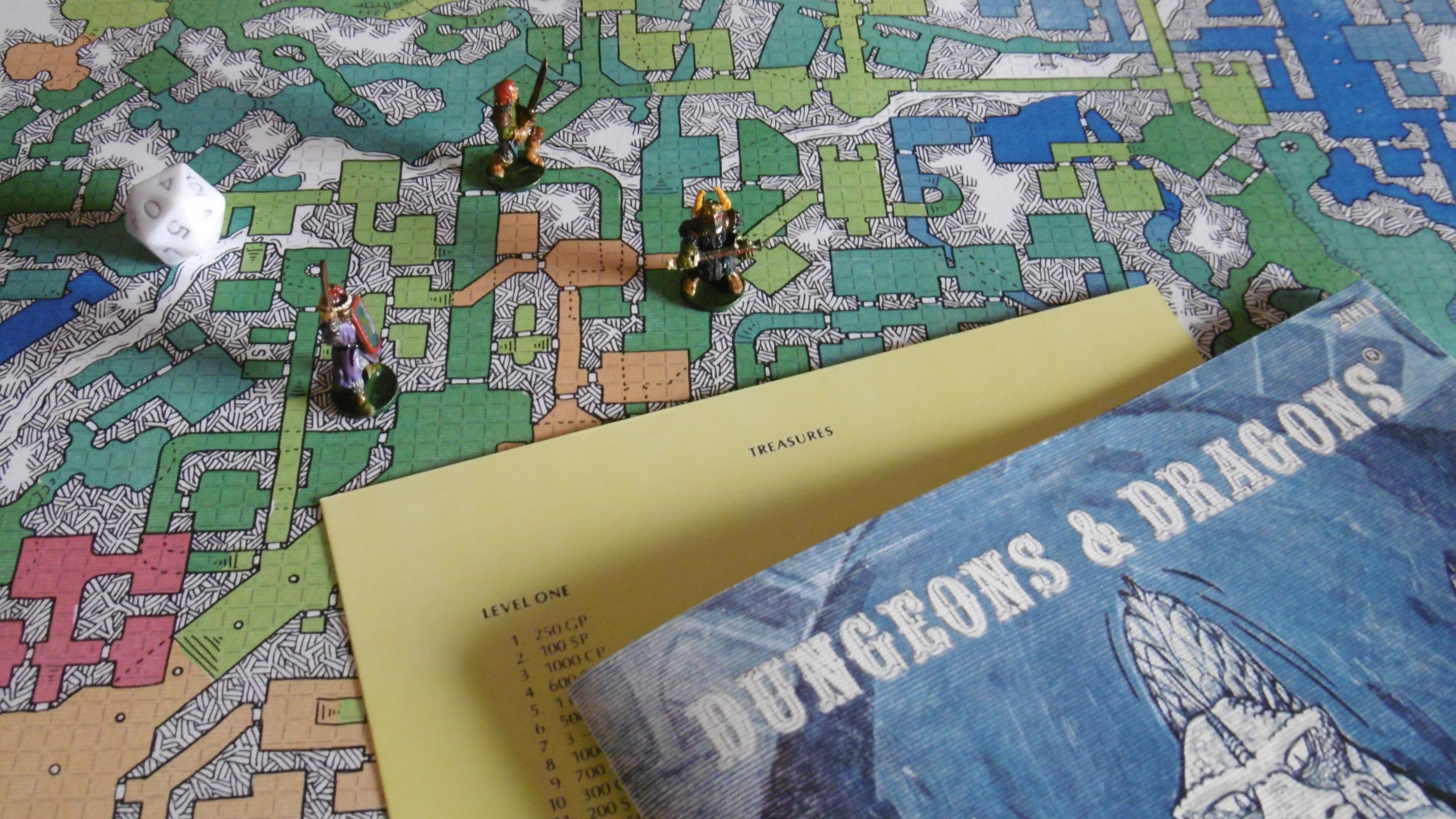
Deadliness Ratio
Using the base sequence above, we come to a stocked-XP to necessary-XP ratio of 23:10.
13,227 + 1,525 = 14,752 stocked XP to 6,513 necessary
14,752:6,513 or 227:100 or, rounding further, 23:10
Lest players be too comfortable with all the padding in the dungeon, we may preserve some “thrill of ‘risking your life’” by rounding down the ratio to an even two times the necessary XP.
6,513 × 2 = 13,026 stocked XP
13,026 − 1,525 = 11,501 XP from treasure
Recalculating t′:
(5 areas × 2t′) + (8 areas × t′) + (2.5 areas × ½t′) = 11,501 g.p.
19.25t′ = 11,501 g.p.
t′ = 11,501 ÷ 19.25
t′ = 597 g.p.
597 ÷ 143 = 4.17 rolls for a single treasure
Thrilling Sequence: 9-4-1
Plugging in a treasure sequence of 9-4-1, we’re only 133 gold short, which is a stocked-to-necessary XP ratio of 198:100 or as close to 2:1 as makes no difference.
Where t equals 143 g.p.,
(5 × 9t) + (8 × 4t) + (2.5 × t) = 79.5t = 11,368 g.p.
11,368 − 11,501 = -133 g.p.
11,368 + 1,525 = 12,893 XP
12,893:6,513 = 198:100 or rounding to 2:1
We could have saved some calculation by adjusting to 50% from 66% on the second application of the rule of thirds. Now we know, though, that the difference between 44% and 50% is near 2,000 XP.
12,893 − 14,803 = -1,910 XP
Our clever party, earning 44% of stocked experience, may struggle.
12,893 × 44% = 5672 ÷ 3 = 1,890 XP each
Only fighting men with a high Strength score (10% prime requisite bonus) advance an experience level along with clerics and thieves.
Treasure-to-Monster Ratio
With a 2:1 stocked-to-necessary XP ratio, our 9-4-1 sequence yields a treasure-to-monster ratio of 75 to 10.
11,368:1,525 = 745:100 or rounding to 75:10
This is almost two times Quasqueton’s ratio and three times the ratio (25:10) calculated using the simple treasure sequence, 2-1-½, from the Flying Dungeon Stocking Table.
“Monty Haul”
Jim Ward is a legend in the role-playing game industry. His design credits include Metamorphosis Alpha (1976), Gods, Demi-Gods & Heroes (1976), and Greyhawk Adventures (1988). Ward learned to play D&D at Gary Gygax’s table, exploring the co-creator’s Greyhawk city and dungeon.
Ward describes, in “The Origin of Monty Haul,” his first experience as a Dungeon Master, running the group gathered at the Gygax home through his own creation. On the dungeon’s first level, the low-level adventurers find an ioun stone and “special sashes that give the wearer martial arts powers,” with which they easily defeat the level’s biggest challenge—three bugbears. Afterward, Ward writes:
“Gary critiqued [the dungeon] by calling me a PRICE IS RIGHT Monty Haul style DM. I gave out too much treasure for the effort.”
With a treasure-to-monster ratio between 7- and 8-to-1, we may, without unreason, expect similar critique.
Proceeding in this “Monty Haul style,” we should wear the term, as Ward does, “as a badge of honor.”
The lantern wanes again, and we’re out of oil. While we make our way back to the entrance, we’ll talk about awarding more experience for gold and look at adjusting for party size and the noncontiguous problem.
Notes
1 In these Deep Halls, we don’t up the strength of monsters to compensate for increased treasures, as Holmes advises. For extracting XP via more slain characters defeats our purpose. If we did increase monster strength, I expect The Deep Halls, though rich in rewards, would become known as a “killer” dungeon.
2 We might think ten rolls is a lot just to get a treasure. Consider, though, that a special or selected monster (as are the double treasures monsters) in any dungeon likely has a lair-type treasure. Take orcs, for example. To determine Treasure Type D, we make at least six rolls—if the orcs have already been cleaned out—and up to a maximum—if the orcs have been lucky—of 15 dice rolls. Then we must multiply by the fraction of the lair’s inhabitants.
3 What I call a “sequence” here is properly a ratio. I use the former to avoid confusion; we have already ratios for deadliness and treasure-to-monster. Further, where a ratio uses colons between terms and a sequence uses commas, I use dashes, again for clarity.
